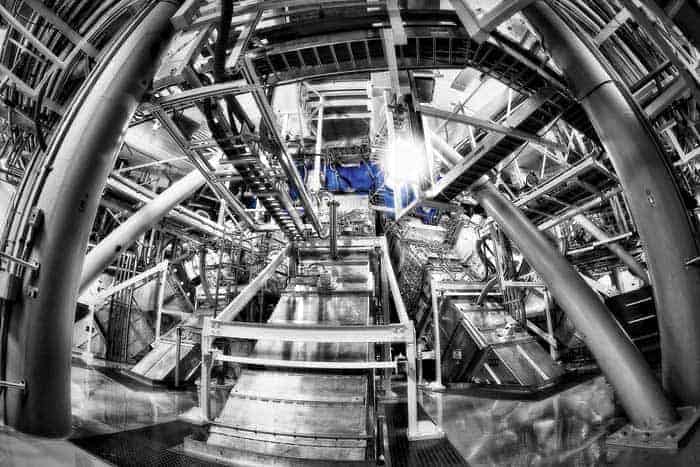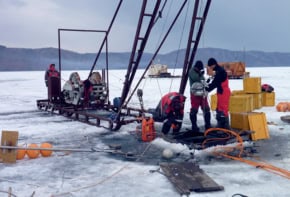After failing to reproduce last year’s record-breaking fusion-energy shot, scientists at the US National Ignition Facility have gone back to the drawing board. Edwin Cartlidge discusses their next steps

On 8 August last year, physicists at the Lawrence Livermore National Laboratory in the US used the world’s biggest laser to carry out a record-breaking experiment. Employing the 192 beams of the $3.5bn National Ignition Facility (NIF) to implode a peppercorn-sized capsule containing deuterium and tritium, they caused the two hydrogen isotopes to fuse, generating a self-sustaining fusion reaction for a fraction of a second. With the process giving off over 70% of the energy used to power the laser, the finding suggested that giant lasers might yet enable a new source of safe, clean and essentially limitless energy.
The result put researchers at the Livermore lab in a celebratory mood, having struggled for more than a decade to make significant progress. But the initial excitement soon faded when several subsequent attempts to reproduce the achievement fell short – mustering at best just half of the record-breaking output. With the Livermore management having decided to try only a handful of repeat experiments, the lab put its quest for breakeven on hold and instead tried to figure out what was causing the variation in output.
For critics of NIF, the latest course correction came as no surprise, apparently illustrating once again the facility’s unsuitability as a test bed for robust fusion-energy production. But many scientists remain upbeat and the NIF researchers themselves have come out fighting, recently publishing the result from their record-breaking shot in Physical Review Letters (129 075001). They insist that they have, after all, achieved “ignition”, reaching the point at which heating from the fusion reactions outweighs cooling, creating a positive feedback loop that rapidly boosts plasma temperature.
Omar Hurricane, chief scientist of Livermore’s fusion programme, maintains that this physics-based definition of ignition – rather than the simple “energy breakeven” description – is the one that really counts. Describing the eventual achievement of breakeven as “the next public relations event”, he nevertheless says that it remains an important milestone that he and his colleagues want to reach. Indeed, physicists from beyond the Livermore lab are confident that the much-discussed target will be hit. Steven Rose at Imperial College in the UK believes that “there is every prospect” breakeven will be achieved.
Record gain
Attempting to harness fusion involves heating up a plasma of light nuclei to the point where those nuclei overcome their mutual repulsion and combine to form a heavier element. The process yields new particles – in the case of deuterium and tritium, helium nuclei (alpha particles) and neutrons – as well as huge amounts of energy. If the plasma can be kept at suitably immense temperatures and pressures for long enough, the alpha particles should provide enough heat to sustain the reactions on their own while the neutrons can potentially be intercepted to power a steam turbine.
Fusion tokamaks use magnetic fields to confine plasmas over fairly long periods. NIF, as an “inertial-confinement” device, instead exploits the extreme conditions created for a fleeting moment inside a tiny quantity of highly compressed fusion fuel before it re-expands. The fuel is placed inside a 2 mm-diameter spherical capsule, which is located at the centre of a roughly 1 cm-long cylindrical metal “hohlraum” and implodes when NIF’s precisely directed laser beams strike the inside of the hohlraum and generate a flood of X-rays.
In contrast to tokamaks, NIF was not designed primarily to demonstrate energy but instead serve as a check on the computer programs used to simulate explosions of nuclear weapons – given that the US ceased live testing in 1992. However, after switching on in 2009 it soon became apparent that the programs used to guide its own operations had underestimated the difficulties involved, in particular when dealing with plasma instabilities and creating suitably symmetric implosions. With NIF missing its initial target to achieve ignition by 2012, the US National Nuclear Security Administration, which oversees the lab, put that objective aside to concentrate on the time-consuming task of better understanding implosion dynamics.
In early 2021, following a series of experimental modifications, Hurricane and colleagues finally showed they could use the laser to create what is known as a burning plasma – in which the heat from alpha particles exceeds the external energy supply. They then made a series of further tweaks, including shrinking the hohlraum’s laser entrance holes and lowering the laser’s peak power. The effect was to shift some of the X-ray energy to later in the shot, which raised the power transferred to the nuclear fuel – pushing it high enough to outpace the radiative and conductive losses.
In August 2021 NIF researchers recorded their landmark “N210808” shot. The hotspot in the centre of the fuel in this case had a temperature of around 125 million kelvin and an energy yield of 1.37 MJ – some eight times higher than their previous best result, obtained earlier in the year. This new yield implied a “target gain” of 0.72 – when compared to the laser’s 1.97 MJ output – and a “capsule gain” of 5.8 when considering instead the energy absorbed by the capsule.
More importantly, as far as Hurricane is concerned, the experiment also satisfied what is known as the Lawson criterion for ignition. First laid out by engineer and physicist John Lawson in 1955, this stipulates the conditions in which fusion self-heating will exceed the energy lost via conduction and radiation. Hurricane says that the NIF results satisfied nine different formulations of the criterion for inertial confinement fusion, thereby demonstrating ignition “without ambiguity”.
Three shots and you’re out
Following the record-breaking shot, Hurricane and some of his fellow scientists at NIF were keen to replicate their success. But the lab’s management were not so enthusiastic. According to Mark Herrmann, then Livermore’s deputy director for fundamental weapons physics, several working groups were set up in the wake of N210808 to assess the next steps. He says that a management team consisting of around 10 experts in inertial confinement pulled those findings together and drew up a plan, which it presented in September.
Herrmann says that the plan contained three parts – attempting to reproduce N210808; analysing the experimental conditions that enabled the record-breaking shot; and trying to obtain “robust megajoule yields”. Discussion of the first point involved what Herrmann describes as “a large variety of opinions” among the roughly 100 scientists working on the fusion programme. In the end, given “limited resources”, and a limited number of targets in the batch containing N210808, he says that the management team settled on just three additional shots.
Hurricane has a slightly different recollection, saying there were four repeats. Those experiments, he says, were carried out over a roughly three-month period and achieved yields that ranged from less than a fifth to around half of that reached in August. But he maintains that these shots were still “very good experiments”, adding that they also satisfied some formulations of the Lawson criterion. The difference in performance, he says, is “not as binary as people have been portraying”.
The plasma-coating process is a recipe, so just like baking bread it doesn’t come out exactly the same every time
Omar Hurricane
As to what caused this huge variation in output, Herrmann says that the leading hypothesis is voids and divots in the fuel capsules, which are made from industrial diamond. He explains that these imperfections can be amplified during the implosion process, causing the diamond to enter the hot spot. Given that carbon has a higher atomic number than deuterium or tritium it can radiate much more efficiently, which cools the hot spot and lowers performance.
Hurricane agrees that the diamond likely plays an important role in varying the shot-to-shot performance. Pointing out that large variations in output are to be expected given the nonlinearity of NIF’s implosions, he says that the scientists involved do not fully understand the plasma-coating process used during fabrication of the capsules. “It’s a recipe,” he says, “so just like baking bread it doesn’t come out exactly the same every time.”
The road to fusion energy
Hurricane says the team is now investigating several ways to raise NIF’s output in addition to improving the capsule quality. These include altering the capsule thickness, changing the size or geometry of the hohlraum, or possibly increasing the laser pulse energy to around 2.1 MJ to lower the precision required for the target. He says there is “no magic number” when it comes to the target gain but adds that the higher the gain the larger the parameter space that can be explored when doing stockpile stewardship. He also points out that a gain of 1 does not mean the facility is generating net energy, given how little of the incoming electrical energy the laser converts into light on the target – in the case of NIF, less than 1%. The long road to ignition
Michael Campbell of the University of Rochester in the US reckons that NIF could achieve a gain of at least 1 “over the next 2–5 years”, given adequate improvements to the hohlraum and target. But he argues that getting up to commercially relevant gains of 50–100 would probably require a switch from NIF’s “indirect drive”, which generates X-rays to compress the target, to the potentially more efficient but trickier “direct drive” that relies on the laser radiation itself.
Despite the several billion dollars that are likely to be needed, Campbell is optimistic that a suitable direct-drive facility can demonstrate such gains by the end of the 2030s – particularly, he says, if the private sector is involved. But he cautions that commercial power plants would probably not start operating until at least the middle of the century. “Fusion energy is for the long term,” he says, “I think people have to be realistic about the challenges.”



